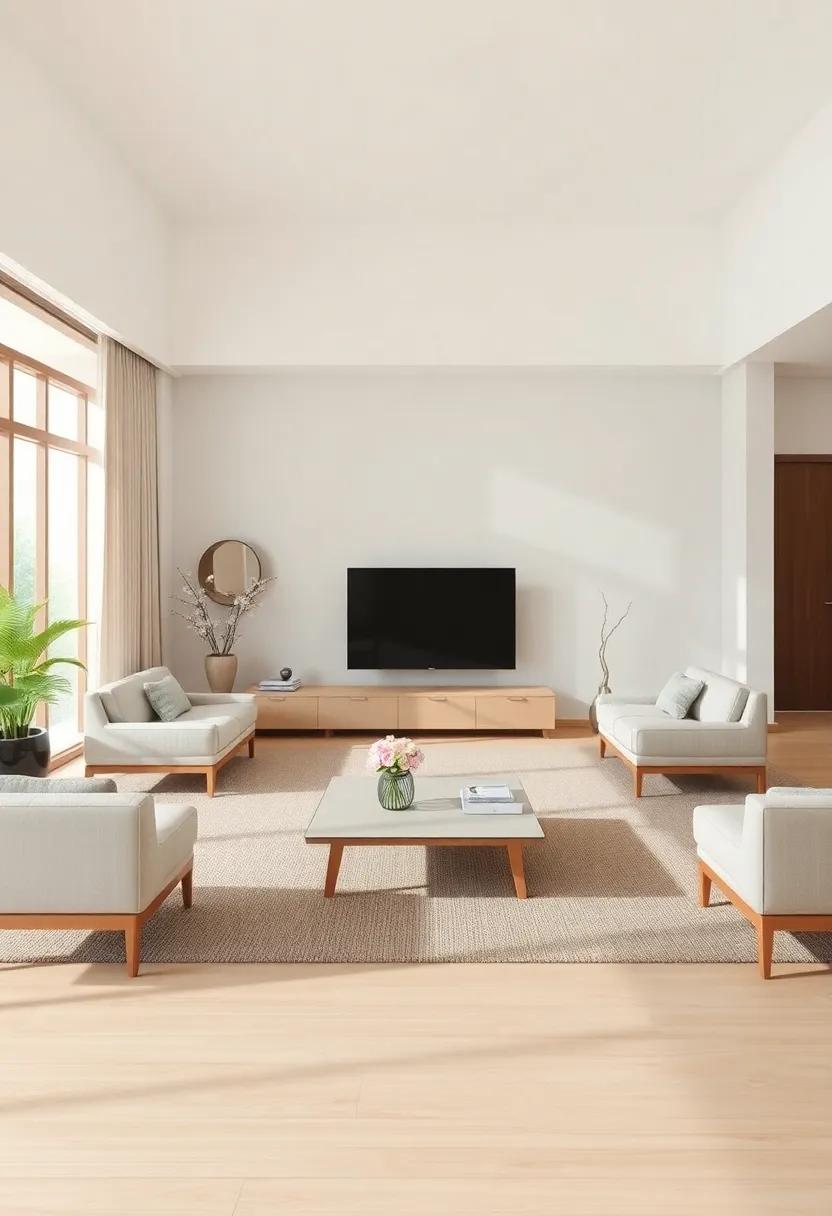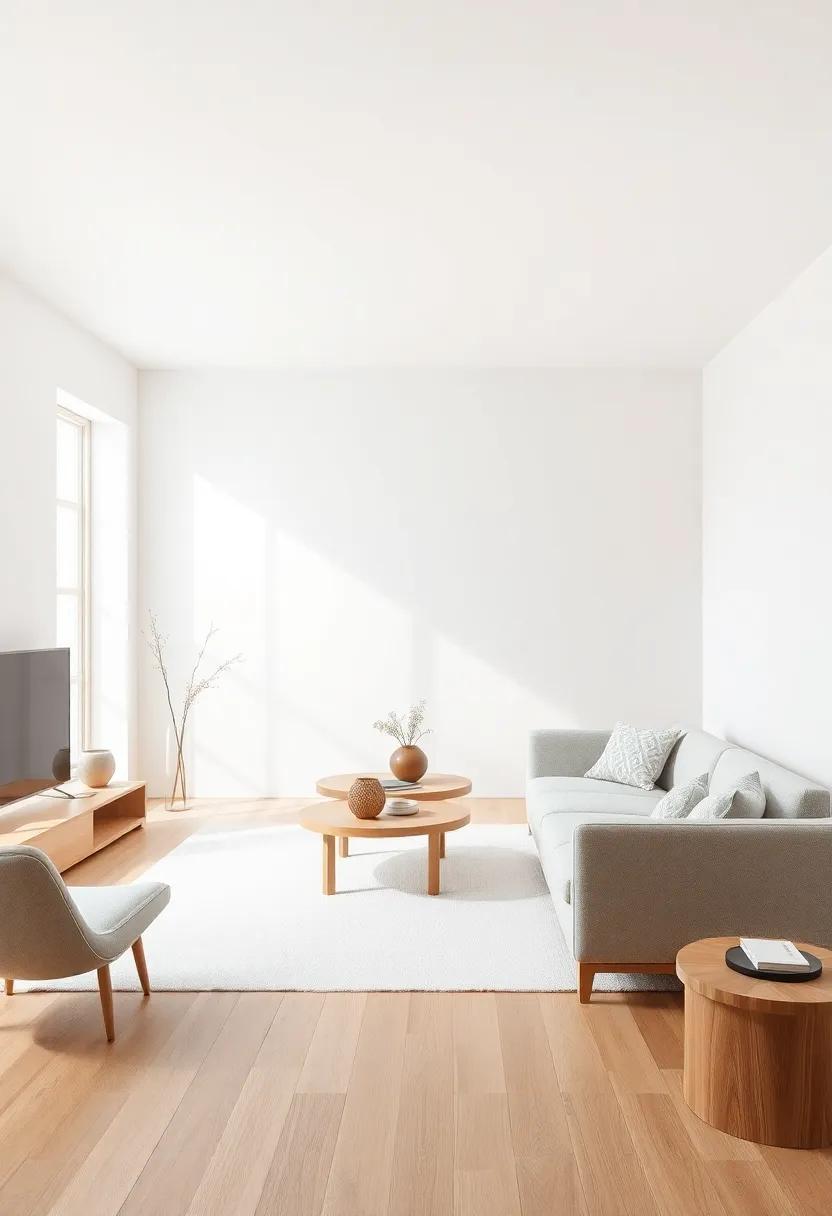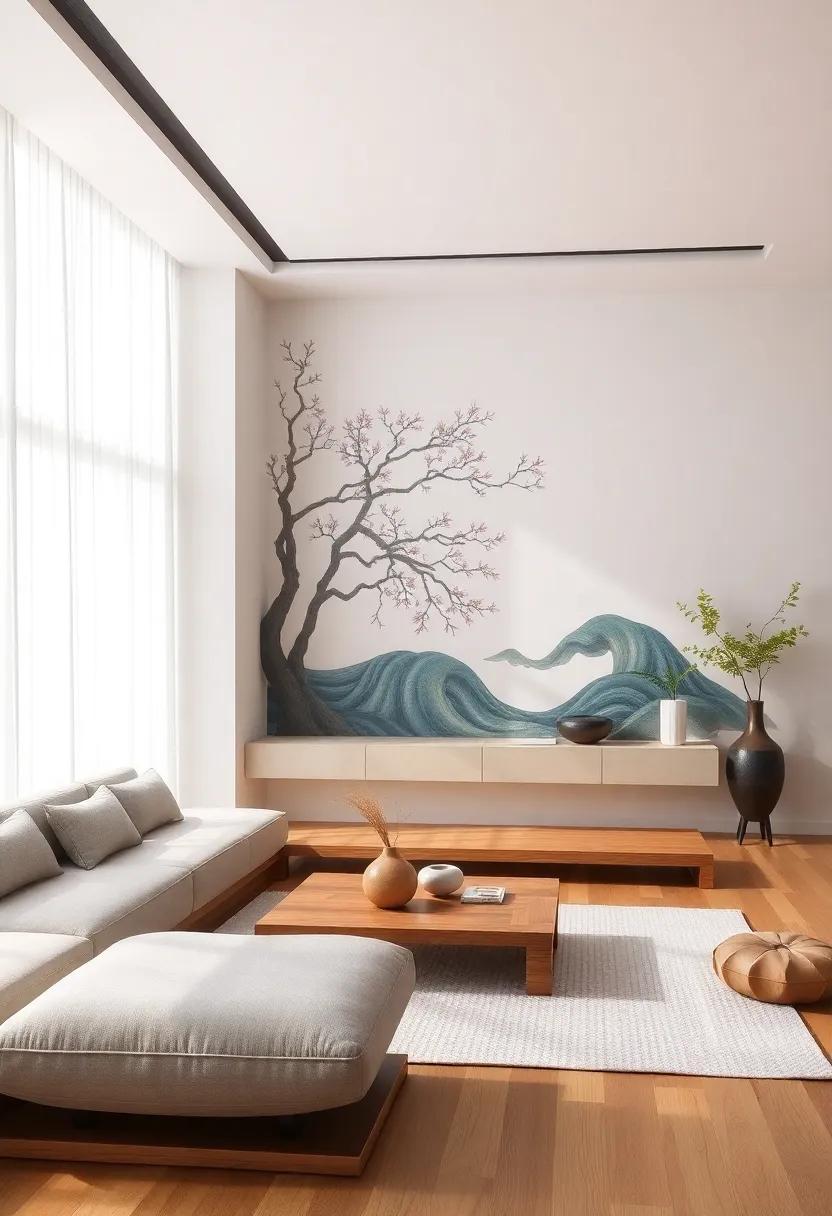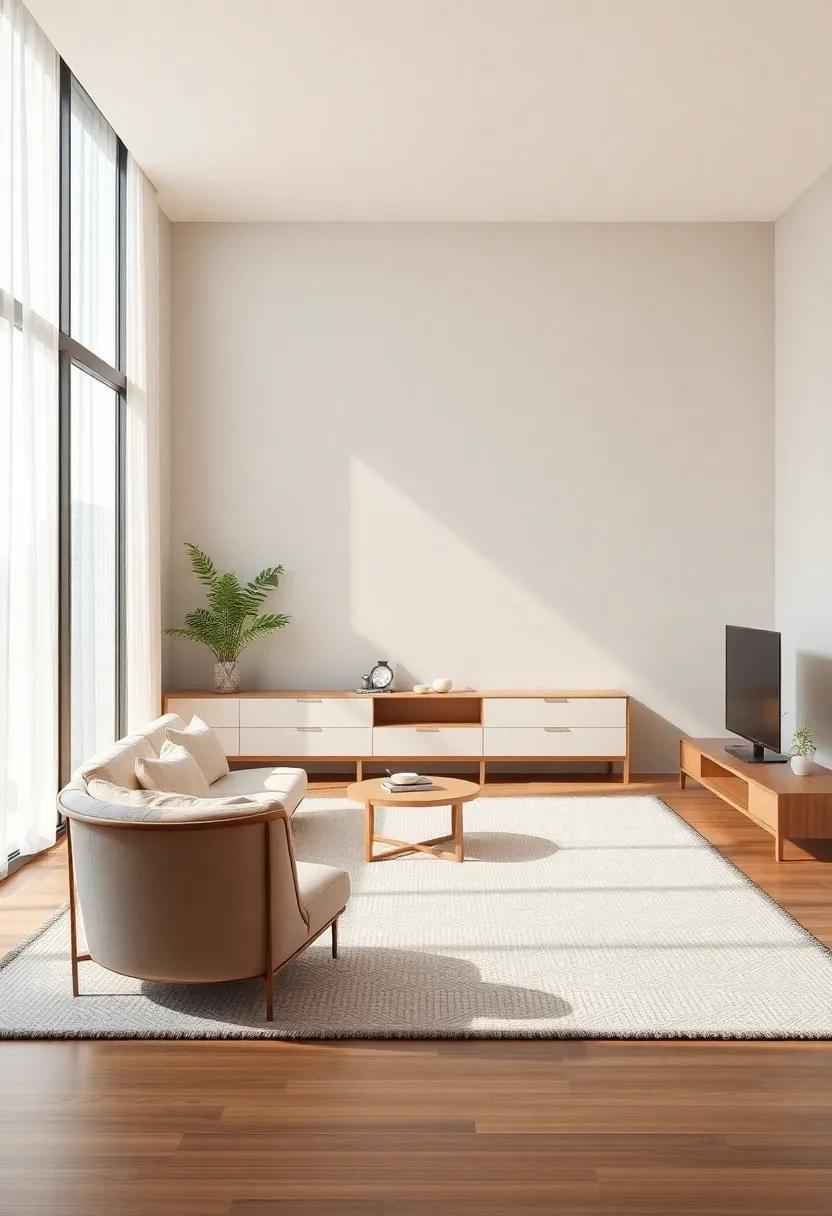
Embrace Serenity: Japanese-Inspired Furniture for a Tranquil Living Room Retreat
In a fast-paced world overflowing with distractions, finding moments of tranquility within our homes has never been more essential. The concept of serenity,deeply rooted in Japanese philosophy,encourages us to create spaces that foster calmness and reflection.Imagine stepping into a living room that embodies simplicity, elegance, and harmony—where every piece of furniture tells a story and contributes to a soothing atmosphere. In this article, we embark on a journey through the art of Japanese-inspired furniture design, exploring how these timeless elements can transform your living space into a serene retreat. From minimalist aesthetics to natural materials, discover how to embrace serenity in your home and cultivate a sanctuary that invites peace and mindfulness into your daily life.
Embracing Minimalistic aesthetics in Japanese-inspired Living Rooms

the essence of Japanese design lies in its simplicity and harmony with nature, elements that can create a serene atmosphere in any living room.By focusing on minimalistic aesthetics, you can effectively transform your space into a tranquil retreat. Consider incorporating furniture that features clean lines and natural materials, such as warm woods and soft fabrics. Items like a low-profile tatami platform bed or a sleek shoji screen can serve as both functional and beautiful focal points. The key is to select pieces that evoke calmness,allowing the space to breathe and promote relaxation.
To further enhance the serene vibe,embrace a muted color palette inspired by nature. Soft whites, greys, and earth tones can work wonders in creating a cohesive design. Add texture with elements like a woven jute rug or subtle paper lanterns,which provide soft lighting without overwhelming the senses. Incorporating a few carefully chosen decorative accents, such as traditional ceramics or minimalist artwork, can provide character without cluttering the space. By focusing on functionality and form, you can effectively cultivate a living room that embodies the principles of Japanese design while offering a peaceful sanctuary for you and your guests.
Capturing Natural Light: The Role of Windows in Creating Serenity

The subtle play of light in a space has the profound ability to influence mood and promote relaxation. large windows,reminiscent of traditional Japanese architecture,serve as natural frames that invite the outside world in,blurring the lines between indoors and nature. Soft, diffused sunlight sifting through sheer panels not only enhances the aesthetic appeal of a room but also fosters a calm ambiance. This translucency can create a gentle glow that transforms your living space, encouraging peaceful moments of reflection amidst a busy day.
To fully embrace this tranquil atmosphere, consider the strategic placement of furniture and decor that harmonizes with natural light. Flowing arrangements and understated colors can work to amplify the effects of daylight. Here are some design elements to ponder:
- low-profile furniture that does not obstruct light
- Light wood tones that reflect sunlight
- Fabrics in soft neutrals and pastels
| Element | Function |
|---|---|
| Sliding Shoji Screens | control light and privacy while maintaining a serene feel |
| Floor cushions | Encourage relaxation and a sense of groundness |
| Organic Planters | Add life and purify air while blending with natural light |
Warm Tones and Earthy Textures: The Palette of Tranquil Spaces

Creating a tranquil living space calls for a thoughtful approach to color and texture.Warm earth tones—think soft browns, muted greens, and gentle terracotta—can be seamlessly combined to forge an inviting atmosphere. Incorporating these shades into your home can transform the heart of your living room into a peaceful retreat.Consider adding elegant touches through natural textures such as:
- rattan furniture that adds a touch of organic warmth
- Natural wood accents for a grounding effect
- Soft linen cushions that invite relaxation
To enhance the calming vibe even further, play with the interplay of light and materials. Tatami mats or textured rugs in neutral tones not only add depth but also provide comfort underfoot, making your living room feel more immersive and serene. Incorporating elements like:
- Stone planters for a rustic, earthy touch
- Clay vases holding simple blooms
- Handmade pottery to introduce artisanal charm
Experiment with these elements to craft a peaceful sanctuary that resonates with tranquility and embraces nature.
Crafting a Zen Corner: The importance of Meditation Areas

In our fast-paced lives,carving out a space dedicated solely to meditation can transform our mental well-being. A zen corner serves as a sanctuary, offering a place to pause, reflect, and reconnect with our inner selves. japanese-inspired furniture, characterized by its minimalism and natural materials, plays an essential role in establishing this tranquil environment. By incorporating elements such as low-profile seating,tatami mats,and shoji screens,you can create a serene atmosphere that encourages mindfulness and deep contemplation.
When designing your meditation area, consider the following components to enhance the experiance:
- Soft Lighting: Use paper lanterns or warm LED lights to foster a calming ambiance.
- Nature Elements: Incorporate indoor plants or a small water feature for soothing sounds and visuals.
- Comfortable Seating: Invest in a zabuton and zafu set for proper posture during practice.
| Furniture type | Purpose |
|---|---|
| Tatami Mat | For grounding and a natural floor surface |
| Shoji Screens | To create privacy and define space |
| Low Table | For tea rituals or contemplation |
Choosing Organic Materials for an Inviting Atmosphere

To create a captivating living space that exudes calm, selecting organic materials is essential. Incorporating elements like bamboo, cotton, and hemp not only adds to the aesthetic but also promotes a sense of harmony and connection with nature. These materials bring warmth and texture, encouraging a serene atmosphere. When considering furniture, look for pieces that highlight natural grains and finishes, allowing the inherent beauty of the materials to shine through.
Additionally, choosing furnishings that feature enduring and eco-friendly practices can enhance the overall ambiance of your retreat. Reclaimed wood,as an example,brings a story and character to your space,while meticulously crafted ceramics offer a tactile contrast to sleek surfaces. To help visualize these choices, consider the following table showcasing some popular organic materials and their benefits:
| Material | Benefit |
|---|---|
| Bamboo | Durable and fast-growing, it’s a sustainable choice. |
| Cotton | Soft and breathable; perfect for cushions and upholstery. |
| Hemp | Resistant to mold, making it great for allergy-friendly spaces. |
| Reclaimed Wood | Unique character with a lower environmental impact. |
| Ceramics | Adds an artisanal feel with vibrant textures. |
The Soft elegance of Tatami Mats: A Foundation for Peace

At the heart of a serene living space lies the understated beauty of tatami mats, which embody the essence of tranquility. Crafted from natural materials, these mats provide a gentle, cushioned surface that not only enhances the aesthetics of your room but also encourages a calming atmosphere. The earthy tones and textured patterns of tatami mats bring a sense of balance, making them an ideal foundation for Japanese-inspired furniture. When arranged thoughtfully, they create a seamless transition between indoor and outdoor spaces, inviting a peaceful harmony that promotes mindfulness and relaxation.
Incorporating tatami mats into your living room design can elevate the entire ambiance, offering a unique canvas for elegant furnishings. To enhance your tranquil retreat, consider the following elements that pair beautifully with tatami:
- Low-profile furniture: A sleek, minimalist coffee table.
- Natural textiles: Cushions and throws made of organic materials.
- Soft lighting: adjustable lamps or paper lanterns that create a warm glow.
- Indoor plants: Greenery that brings life and freshness to the space.
By blending these elements with the soft elegance of tatami, your living room can transform into an oasis of calm. The presence of tatami fosters a relaxed mindset, inviting you to unwind while enjoying the serene style of Japanese design.
Harmonizing Space: The Art of Furniture Arrangement

Creating a serene living space begins with an understanding of balance and harmony in furniture arrangement. Emulating the principles of japanese design, consider utilizing natural materials that evoke a sense of calm. This includes items like:
- Bamboo furniture, which provides a light, airy feel.
- Wooden tatami mats that introduce warmth and texture.
- Neutral color palettes, such as soft whites and earthy tones, to promote tranquility.
These elements not only enhance aesthetic appeal but also embody the essence of minimalism, allowing space to breathe and fostering a sense of relaxation.
Incorporating a thoughtful layout is essential to achieving a harmonious atmosphere. Place larger pieces, like a low-profile sofa, against a wall to create an open flow. Consider the following positioning strategies to maintain balance:
| Furniture Type | Placement Tips |
|---|---|
| Armchairs | Angle them towards the sofa for conversation. |
| Coffee Tables | Keep it low and close for easy reach. |
| Bookshelves | Flank them with plants to soften hard lines. |
This careful consideration of layout and furniture choice creates an inviting retreat, encouraging both relaxation and connection with nature.
Simplicity in Design: The Beauty of minimalist Furniture

Minimalist furniture embodies the essence of serenity, favoring clean lines and functional designs that create an uncluttered space. Japanese-inspired pieces often highlight natural materials such as wood and bamboo, emphasizing textures and subtle colors that foster a sense of calm. With a focus on simplicity, each item serves a purpose, removing distractions and allowing the eye to appreciate the beauty of each form. Elements like tatami mats and low-profile seating further enhance the tranquil atmosphere, inviting relaxation whilst promoting mindfulness in everyday living.
To fully embrace minimalism in your living room, consider integrating the following essential elements:
- Low furniture: Opt for low seating options like floor cushions or futons.
- Natural light: Maximize sunlight by keeping window treatments light and breezy.
- Calming color palette: Use soft, neutral tones to maintain a peaceful ambiance.
- Functional accessories: Include only essential decor,such as simple vases or subtle art.
| Furniture Type | Description |
|---|---|
| shikibuton | A traditional Japanese sleeping mat, perfect for minimalist decor. |
| Zaisu Chair | Low-back seating without legs, ideal for floor-based living. |
| Kumiko Table | Intricate woodwork highlighting craftsmanship, great for communal spaces. |
adding Nature’s Touch: Incorporating Indoor Plants and Decor

Bringing the calmness of nature indoors enhances the serene atmosphere inspired by japanese design. Indoor plants, such as bamboo, peace lilies, and fiddle leaf figs, can effortlessly connect your living space to the tranquility found in traditional Japanese gardens. These natural elements not only purify the air but also add a refreshing touch to your décor. to create a cohesive look, consider using decorative pots in natural materials like clay or stone, which harmonize beautifully with minimalist furniture.
Accent your living room with thoughtful decor choices that reflect the simplicity and elegance of Japanese aesthetics. Incorporating elements such as:
- Shoji screens for a flexible room divider
- Wooden trays to hold your indoor plant pots
- Tatami mats for flooring or as an area rug for a touch of authenticity
can further enhance the feeling of tranquility. mixing these items with soft cushions in neutral colors invites relaxation while reinforcing the theme of peace and harmony. Create small vignettes around your space, utilizing natural materials and minimalistic design, allowing the beauty of each piece to shine without overwhelming the senses.
Creating Balance with Symmetrical Arrangements

the essence of Japanese design lies in its profound thankfulness for simplicity and harmony, especially through the use of symmetrical arrangements. An inviting space can be achieved by positioning furniture items that mirror each other, allowing for a calm and balanced atmosphere.Consider the following elements to enhance the visual equilibrium in your living room:
- Two identical armchairs flanking a low-profile coffee table create a sense of invitation.
- A pair of floor lamps can illuminate each side, enhancing the symmetrical layout.
- A central piece of art or a mirror can serve as a focal point, drawing the eye and maintaining balance.
Further augmenting the sense of tranquility, the use of natural materials and muted tones helps ground the space. By integrating elements such as a wooden console table or stone planters, the organic textures contribute to an overall serene effect. To visualize how these elements align, consider the following table:
| Furniture Piece | Function | Key Feature |
|---|---|---|
| Armchair | Seating | Identical design for balance |
| Coffee Table | Surface space | Low-profile for openness |
| Floor Lamp | Lighting | Symmetrical placement |
By thoughtfully arranging these components, you cultivate a living room that feels both cohesive and serene, transforming your home into a tranquil retreat. Embracing the principles of symmetry not only enhances aesthetics but also fosters a peaceful ambiance, ideal for relaxation and meditation.
Subtle Lighting: Designing an Ambient Space with Lamps and Lanterns

Creating a peaceful retreat in your living room often hinges on the quality of the lighting. To achieve a harmonious ambiance, consider integrating a variety of lamps and lanterns that echo Japanese aesthetics. Soft, diffused light plays a pivotal role in establishing a serene atmosphere, and your choice of fixtures can enhance this tranquility. Embrace fixtures made from natural materials like rice paper or wood to evoke traditional Japanese elements. Incorporate:
- Paper Lanterns: These offer a warm glow, reminiscent of serene landscapes.
- Floor Lamps: Adjustable height options can create targeted lighting for reading or conversation.
- Table Lamps: Softly lit tables can act as focal points, enhancing both functionality and aesthetics.
Along with these fixtures, the arrangement of lighting sources is crucial. Group several lamps together in one area to create cozy nooks, or allow for spacing that encourages openness and relaxation. Consider using a dimmer switch to adjust the intensity according to mood and time of day. You can explore light layering, combining ambient, task, and accent lights to personalize your space. Here’s a simple illustration of ideal lamp placement:
| Location | Type of Lighting | purpose |
|---|---|---|
| Corner Reading Nook | floor Lamp | Task lighting for reading |
| Coffee Table Area | Table Lamps | Accent and ambient light |
| full Room | Ceiling Fixture | Overall ambient light |
Cultural Symbols: Enhancing Serenity with Japanese Art

In Japanese culture, art often serves as a bridge to tranquility, embodying a deep connection with nature and spirituality. One of the most effective ways to enhance the serenity of your living space is by incorporating traditional Japanese motifs that evoke a sense of peace.Elements such as minimalistic designs, organic shapes, and natural materials can transport you from the chaos of modern life to a space of calm. Consider elements like:
- Shiki (Japanese tatami mats) for a touch of authenticity and comfort
- Bonsai trees for a living art piece that requires care and attention
- japanese calligraphy featuring Zen phrases that inspire mindfulness
Additionally, the use of color plays a significant role in crafting a serene environment.Opt for muted hues frequently enough found in japanese landscapes, such as soft greens and gentle earth tones. These colors can enhance your furniture and decor,bringing harmony to your living room. To effectively balance these elements, consider a table layout that highlights the core features:
| Element | Description |
|---|---|
| Tatami mats | Natural fiber flooring that promotes relaxation. |
| Futons | Simple bedding that emphasizes minimalism. |
| Low Coffee Tables | encourages a casual and inviting atmosphere. |
Integrating Smooth Lines: The Influence of Japanese Origami

Japanese origami embodies a philosophy of simplicity and elegance, qualities that resonate deeply in contemporary furniture design. The careful folding techniques seen in origami translate into furniture pieces that evoke a sense of lightness and harmony. The smooth lines and curves not only enhance the aesthetic appeal but also create a calming atmosphere. When pieces are designed with flowing forms, they become less about their physical presence and more about the feeling they evoke within a space. Furniture inspired by this art form frequently enough includes:
- Curvilinear structures that mimic the grace of nature
- Modular components that can be rearranged to promote relaxation
- Minimalist designs that focus on functional beauty
By utilizing materials that reflect authenticity, such as natural wood and soft textiles, designers can ensure that each piece fosters a sense of peace. In doing so, they honor the origami tradition of transforming a simple sheet of paper into an intricate creation while maintaining a balance between form and function. Consider the following table showcasing essential elements of Japanese-inspired furniture:
| Element | Description | Impact |
|---|---|---|
| Soft Curves | Gentle, flowing lines that invite relaxation | Creates a soothing environment |
| Natural Materials | Use of wood, bamboo, or organic fabrics | Enhances tactile warmth |
| Functional Elegance | Sleek designs that maximize usability | Promotes a clutter-free space |
Showcasing Craftsmanship: The Allure of Handcrafted Furniture

In the world of interior design, handcrafted furniture stands out as a testament to artistry and dedication. Each piece tells a story, woven from meticulous techniques that transform raw materials into functional art. Emphasizing simplicity and elegance, Japanese-inspired furniture reflects a harmonious blend between nature and decor, effortlessly creating a serene ambiance. By choosing handcrafted elements, you not only support skilled artisans but also bring unique character into your living space. The refined lines and natural finishes of these pieces resonate deeply with those seeking tranquility in their surroundings.
Consider integrating pieces that embody the essence of Japanese aesthetics. Think low-profile tatami beds, slender minimalist coffee tables, and handcrafted cabinetry that showcase the beauty of natural wood grains. The following table highlights essential characteristics of handcrafted Japanese-inspired furniture:
| Furniture Type | Key Features | Benefits |
|---|---|---|
| Low-Profile Beds | simple,sleek lines | Promotes calm and restful sleep |
| Minimalist Coffee Tables | Natural wood finishes | Encourages a serene gathering space |
| handcrafted Cabinets | Unique craftsmanship | Adds character and storage utility |
Opting for these pieces nurtures a peaceful environment that invites relaxation into your daily routine. Each handcrafted item, with its distinct texture and warmth, encourages a mindful connection with your living space, enhancing not just aesthetics but overall well-being.
the Serenity of Low Seating: Embracing Japanese Floor Designs

Low seating arrangements, a hallmark of traditional Japanese floor designs, invite a sense of connection to the ground and the environment. This design philosophy emphasizes a tranquil atmosphere, promoting relaxation and mindfulness. The choice of materials, such as natural woods and soft textiles, enhances the calming effect, creating a warm and welcoming space. By incorporating elements like tatami mats and zaisu chairs, one can transform a living room into a serene retreat where the art of simplicity reigns supreme.
To further encapsulate the beauty of low seating, consider integrating a few key pieces that reflect the essence of Japanese aesthetics. The following elements are essential for achieving harmony in your space:
- Low Tables: Perfect for intimate gatherings and tea ceremonies.
- Floor Cushions: Offer comfort and adaptability with vibrant patterns or subtle designs.
- Sliding Shoji Screens: Provide privacy while maintaining an airy feel.
- Woven Baskets: Serve as stylish storage solutions without cluttering the space.
By embracing these low seating concepts, you craft not just a living room, but a sanctuary that encourages tranquility and mindful living. Mixing functionality with minimalist beauty allows the space to resonate with peace,igniting a sanctuary where the art of living can be celebrated.
Curating a Collection of Meaningful Decor Items

In crafting a serene living space, the selection of decor items plays a pivotal role in creating a harmonious ambiance. Begin by considering natural materials that resonate with the essence of japanese design. Incorporate elements such as:
- Wooden Accents: Opt for pieces made from light-colored woods,like bamboo or pine,that add warmth and texture.
- Stone and Ceramics: Integrate handmade ceramic vases or stone sculptures that embody simplicity and authenticity.
- Textiles: Choose soft fabric cushions and throws in muted tones to evoke a sense of calm.
Additionally, the placement of these items is crucial in achieving a balanced look. Strategically utilize open space to encourage a flow that mimics the tranquility of nature. Consider creating a minimalist focal point, such as a low table adorned with a single, captivating decorative piece. You might also explore the option of organizing a modest display shelf that follows the principles of asymmetry and balance. A simple table showcasing selected items can be a striking centerpiece:
| Item | Purpose |
|---|---|
| ikebana Vase | To showcase minimalist flower arrangements. |
| Zen Sand Garden | For meditation and reflection. |
| Handwoven Throw | add warmth and comfort. |
Retreating into Comfort: Selecting the Right Textiles

Creating a peaceful sanctuary within your living space begins with the careful selection of textiles that evoke a sense of calm and comfort. In the realm of Japanese aesthetics, simplicity and tactile quality reign supreme. Consider opting for natural fibers such as cotton, linen, and silk, which not only breathe well but also bring a touch of organic elegance to your environment. A harmonious color palette featuring soft earth tones,muted pastels,or gentle greys can further enhance the tranquil atmosphere you wish to achieve. Prioritize minimalist patterns and designs,steering away from overly busy prints to maintain a serene visual space.
When choosing textiles, focus on incorporating elements that inspire relaxation and mindfulness. Essential additions may include:
- Mochi cushions: Soft, versatile seating options that invite comfort.
- Shiki sheets: Lightweight bedding that transforms your seating into a cozy nook.
- Woven tatami mats: Natural floor coverings that offer warmth and texture.
- Organic cotton throws: Cozy layers that add warmth without bulk.
In your selection process, consider creating a textural contrast by pairing smooth surfaces with rougher textures, allowing for a dynamic yet peaceful living space.Below is a simple guide that illustrates how to balance these elements effectively:
| Textile Type | Suggested Use | Balance Approach |
|---|---|---|
| Silk | Cushion covers | Contrast with a natural linen throw |
| Cotton | Window treatments | Pair with textured jute rugs |
| Wool | Blankets | Balance with soft cotton upholstery |
Welcoming Calm with Functionality: Multi-Purpose Furniture Solutions

In a world where space is often a luxury, the integration of multi-purpose furniture becomes essential in creating a tranquil living room that embodies serenity. Japanese-inspired design emphasizes simplicity and function, allowing pieces to serve dual roles without overwhelming the space. As an example, a traditional low-profile coffee table can transform effortlessly into a dining space when needed, or a beautifully crafted futon can serve as both a couch and a guest bed, maximizing utility while maintaining a minimalist aesthetic.
Choosing the right pieces involves recognizing those that harmonize with the calming principles of Japanese decor. Consider the following features to embrace functionality without sacrificing style:
- Modular designs: Flexible furniture that can be rearranged to fit different activities.
- Natural materials: Woods and textiles that promote a sense of connection with nature.
- Storage solutions: Built-in compartments that help maintain a clutter-free environment.
These elements, when thoughtfully incorporated, assist in crafting a living room that is not only serene but also practical, allowing you to embrace calmness in everyday interactions.
The Way Forward
In a world that frequently enough feels chaotic and overwhelming, transforming your living room into a serene sanctuary can be a game changer for your well-being. By embracing Japanese-inspired furniture, you invite a sense of calm, simplicity, and functionality into your space, laying the foundation for a tranquil retreat. Each piece,infused with thoughtful design and natural materials,encourages mindfulness and connection to the present moment. As you embark on this journey to create your own oasis, remember that the essence of serenity lies not just in the aesthetic, but in the atmosphere you cultivate—a space that nurtures relaxation, inspires reflection, and welcomes you home.So take a deep breath, let go of the clutter, and embrace the harmony that comes with a Japanese aesthetic inspired living room. Your peaceful retreat awaits.
As an Amazon Associate I earn from qualifying purchases.



